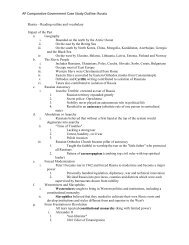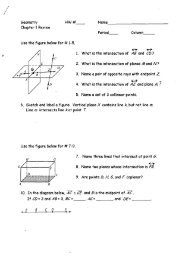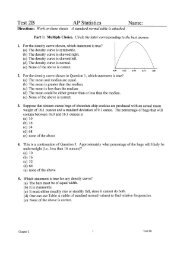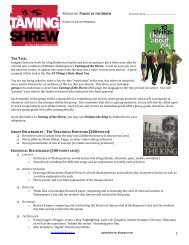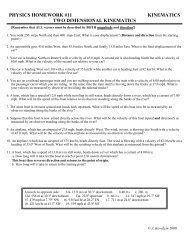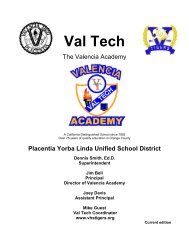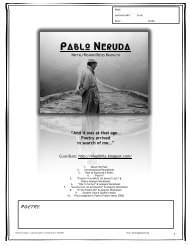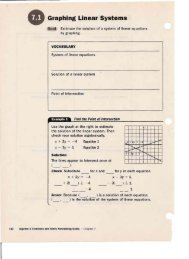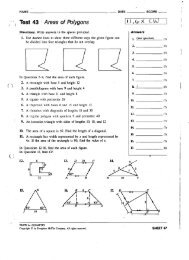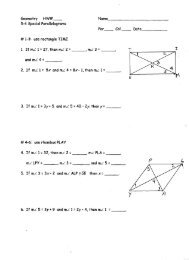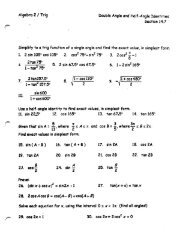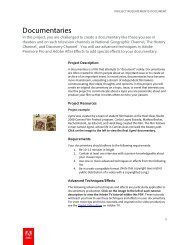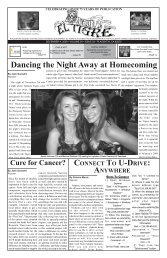LITERATURE CIRCLE FRAMES
LITERATURE CIRCLE FRAMES
LITERATURE CIRCLE FRAMES
You also want an ePaper? Increase the reach of your titles
YUMPU automatically turns print PDFs into web optimized ePapers that Google loves.
<strong>LITERATURE</strong> <strong>CIRCLE</strong>S + <strong>FRAMES</strong>=HANDS-ON SCHOLARSHIP <br />
<strong>LITERATURE</strong> <strong>CIRCLE</strong> <strong>FRAMES</strong><br />
<br />
<br />
<br />
<br />
<br />
<br />
Group Expectations & Rules<br />
Assignment Sheet<br />
Rubric<br />
Roles<br />
o Discussion Director<br />
o Illustrator<br />
o Literary Luminary<br />
o Connector<br />
o Profiler<br />
o Word Finder<br />
Conversational Roundtable<br />
Frayer Model<br />
DAVID N. CHUNG, Valencia H.S., PYLUSD. EMAIL: dnchung@pylusd.org<br />
MINI-WORKSHOP: PAGE 1
GROUP NORMS<br />
GROUP EXPECTATIONS<br />
[Adapted from Long Beach USD GATE Office]<br />
<strong>LITERATURE</strong> <strong>CIRCLE</strong>S + <strong>FRAMES</strong>=HANDS-ON SCHOLARSHIP <br />
Expectations How it looks with the Role How it looks with the Discussion/Presentation<br />
INTELLECTUAL COURAGE<br />
Takes risks<br />
Respectfully Challenge Others<br />
Actively Participate<br />
Think “outside the box”<br />
<br />
<br />
Take the initiative<br />
Go above and beyond what the<br />
Literature Circle Role requires [be<br />
thorough and insightful]<br />
<br />
<br />
<br />
<br />
Courteous to one another<br />
Focus and Re-focus (when off-topic) on<br />
the common text<br />
Can add analysis and/or provide a<br />
connection to another student’s<br />
interpretation<br />
Students keep each other accountable<br />
INTELLECTUAL LEADERSHIP<br />
Lead by being a role model for<br />
others<br />
Take the initiative<br />
Be prepared<br />
Help others with learning<br />
<br />
<br />
<br />
<br />
Students should read the selected<br />
literature before the discussion meeting<br />
[following through with responsibility]<br />
Positive Interdependence: encourage<br />
each other to accomplish the tasks<br />
Use Social Skills/Etiquette<br />
Group Evaluation: keep each other<br />
accountable with constructive criticism.<br />
<br />
<br />
<br />
<br />
<br />
Prepare to agree, disagree, and/or<br />
affirm with evidence not just opinion.<br />
Learn together as a group<br />
Seek to respect all other participants<br />
Seek to include not alienate or offend<br />
Tactful in challenging others to be<br />
thorough and insightful in their<br />
response<br />
INTELLECTUAL HUMILITY<br />
Practice Scholarly Behavior<br />
Do not steal others’ opportunities<br />
to learn and think<br />
<br />
<br />
<br />
<br />
Positive Interdependence<br />
Individual Accountability<br />
Consider advice from peers<br />
Make and take the time to complete<br />
the role [no last minute, lunch-time<br />
copying!]<br />
<br />
<br />
<br />
<br />
<br />
Listen actively to the speaker<br />
No Interruptions or sidebars<br />
Open-minded attitude<br />
Respect the right to speak<br />
Everyone works together towards<br />
understanding multiple perspectives<br />
and a shared understanding<br />
INTELLECTUAL AGGRESSIVENESS<br />
Use evidence to support your<br />
ideas<br />
Defend your thoughts<br />
Use multiple resources<br />
<br />
<br />
<br />
Group Evaluation<br />
Refer to the literature/text for<br />
evidence/support<br />
Be voracious about reading, tenacious<br />
about interpretation and analysis<br />
<br />
<br />
<br />
<br />
<br />
Share point of view/opinion<br />
Refer to the text<br />
Share your best thinking<br />
Everyone works together towards<br />
understanding multiple perspectives<br />
and a shared understanding<br />
Expect other people’s reflections will<br />
improve your thinking/understanding<br />
GROUP RULES<br />
Based on our Intellectual Exp ectations, our F our Rules for Effectiv e Literature Circles are…<br />
ISSUE RULE LOOKS/SOUNDS LIKE…<br />
RESPECT<br />
PARTICIPATION<br />
TIME<br />
PREPARATION<br />
SHOW COURTESY AND RESPECT AT ALL TIMES<br />
EVERYONE SHARES AND EVERYONE “ACTIVELY”<br />
LISTENS<br />
USE OUR TIME WISELY: “STAY ON TASK”<br />
SET, MAINTAIN (ACCOUNTABILITY) AND<br />
ACCOMPLISH OUR GOAL/S<br />
What’s rude…<br />
What’s respect…<br />
No Put-downs<br />
Help everyone understand<br />
Daydreamers<br />
Individualists vs. Interdependence<br />
Sidebars…<br />
What to do if/when “off-task”<br />
Read the selected text<br />
Complete responses/roles<br />
Set goal: “By the end of 20 minutes, we will…”<br />
DAVID N. CHUNG, Valencia H.S., PYLUSD. EMAIL: dnchung@pylusd.org<br />
MINI-WORKSHOP: PAGE 2
<strong>LITERATURE</strong> <strong>CIRCLE</strong>S + <strong>FRAMES</strong>=HANDS-ON SCHOLARSHIP <br />
ASSIGNMENT SHEET<br />
[by SHORT STORY, POETRY, ARTICLE, SELECTED<br />
PASSAGES/CHAPTERS]<br />
Your Name:<br />
Class:<br />
Start Date: ____________ Final Due Date: ____________<br />
Score:<br />
TASK:<br />
After selecting what literature you will be reading…<br />
Decide as a group the number of pages to be read and who will complete what role for that reading. The reading of the<br />
literature and Literature Circle Role must be completed BEFORE each discussion.<br />
For every literature circle meeting, you must have a different role.<br />
Meeting #1 on<br />
_________________(Date)<br />
Meeting #2 on<br />
_________________(Date)<br />
Meeting #3 on<br />
_________________(Date)<br />
& Lit. Circle PRESENTATION<br />
TITLE of<br />
Literature/<br />
AUTHOR<br />
____________________ ____________________ __________________________<br />
CHAP/PAGE #<br />
Role/Task Name of Group Member Name of Group Member<br />
Name of Member &<br />
PRESENTATION Responsibilities<br />
Profiler<br />
Connector<br />
Illustrator<br />
Word<br />
Finder<br />
Literary<br />
Luminary<br />
Discussion<br />
Director<br />
OTHER:<br />
What’s Next<br />
We will discuss<br />
pg ____ to pg ____ for the next<br />
meeting.<br />
Due:<br />
We will discuss<br />
pg ____ to pg ____ for the next<br />
meeting.<br />
Due:<br />
Group Presentation of<br />
_________________________________<br />
[Product]<br />
on _____________________<br />
[Due Date]<br />
DAVID N. CHUNG, Valencia H.S., PYLUSD. EMAIL: dnchung@pylusd.org<br />
MINI-WORKSHOP: PAGE 3
<strong>LITERATURE</strong> <strong>CIRCLE</strong>S + <strong>FRAMES</strong>=HANDS-ON SCHOLARSHIP <br />
<strong>LITERATURE</strong> <strong>CIRCLE</strong> ASSESSMENT RUBRIC FOR ROLES<br />
Lit. Circle Objective: Increase our Understanding of Literature Through<br />
Meaningful, Interpretive, and Evaluative Analysis, Discussion, and Presentation<br />
<strong>LITERATURE</strong> <strong>CIRCLE</strong> ROLE [circle one]:<br />
NAME:<br />
CLASS:<br />
ASSIGNMENT:<br />
DATE:<br />
Discussion Director Literary Luminary Word Finder Illustrator Connector Profiler Combination of Roles<br />
TASK: In your own words, summarize what your task is with this role.<br />
HIGHLIGHT/<strong>CIRCLE</strong> FOR EACH COMPONENT BASED ON YOUR PERFORMANCE IN YOUR OWN ROLE, READING, AND COLLABORATION.<br />
COMPONENT/<br />
RUBRIC SCORE<br />
1 2 3 4<br />
ROLE<br />
FULFILLMENT<br />
<br />
<br />
<br />
<br />
<br />
Rarely completes role<br />
tasks properly and not<br />
always on time<br />
Tasks are done with<br />
little or no genuine<br />
effort<br />
No developed<br />
response to show<br />
understanding or<br />
interpretation of a<br />
passage<br />
Does not address the<br />
parts of the role<br />
No textual evidence<br />
provide and/or does<br />
not support the<br />
response<br />
<br />
<br />
<br />
<br />
<br />
Sometimes completes<br />
role tasks properly<br />
but not always on<br />
time<br />
Tasks are done with<br />
minimal effort<br />
Little development of<br />
response to show<br />
understanding or<br />
interpretation of a<br />
passage<br />
Incompletely<br />
addresses parts of<br />
the role<br />
Little textual evidence<br />
provided to support<br />
the response<br />
<br />
<br />
<br />
<br />
<br />
Completes role tasks<br />
independently and on<br />
time<br />
Tasks are<br />
thoughtfully done<br />
with genuine effort<br />
Attempts to<br />
demonstrate<br />
understanding and/or<br />
interpretation of a<br />
passage<br />
Clearly addresses<br />
most parts of the role<br />
Provides textual<br />
evidence relevant to<br />
the response<br />
<br />
<br />
<br />
<br />
<br />
Completes role tasks<br />
independently and<br />
on time<br />
Tasks are thoroughly<br />
& thoughtfully done<br />
demonstrating an<br />
extension of the role<br />
Demonstrates new,<br />
scholarly insight,<br />
developed<br />
understanding<br />
and/or interpretation<br />
of a passage<br />
Clearly addresses all<br />
parts of the role<br />
Provides relevant<br />
and insightful textual<br />
evidence to all<br />
responses<br />
READING<br />
Assigned reading rarely<br />
completed on schedule<br />
Sometimes has assigned<br />
reading completed on<br />
schedule<br />
Has assigned reading<br />
completed on schedule<br />
Has assigned reading<br />
completed on schedule<br />
with completed “notes”<br />
DISCUSSION<br />
<br />
<br />
Does not participate in<br />
group discussions<br />
Offers few opinions<br />
and makes no personal<br />
connections to the text<br />
<br />
<br />
Participates<br />
reluctantly in group<br />
discussions<br />
Offers few opinions<br />
and makes limited<br />
connections to the<br />
text<br />
<br />
<br />
Participates<br />
competently in group<br />
discussions<br />
Offers some insightful<br />
opinions and makes<br />
connections to the<br />
text<br />
<br />
<br />
Participates<br />
enthusiastically in<br />
group discussions<br />
Offers insightful,<br />
scholarly and<br />
thoughtful opinions<br />
and makes pertinent<br />
connections to the<br />
text<br />
COMMENTS/REFLECTION:<br />
WHAT WENT WELL AND WHY…<br />
ONE AREA TO IMPROVE…<br />
WHAT STEPS WILL I TAKE TO ENSURE SUCCESS FOR MY NEXT <strong>LITERATURE</strong> <strong>CIRCLE</strong>?<br />
DAVID N. CHUNG, Valencia H.S., PYLUSD. EMAIL: dnchung@pylusd.org<br />
MINI-WORKSHOP: PAGE 4
<strong>LITERATURE</strong> <strong>CIRCLE</strong>S + <strong>FRAMES</strong>=HANDS-ON SCHOLARSHIP <br />
<strong>FRAMES</strong>, <strong>LITERATURE</strong> <strong>CIRCLE</strong> ROLE:<br />
Discussion<br />
Director<br />
NAME:<br />
Subject:<br />
Assignment:<br />
Date:<br />
Pages:<br />
CONTENT STANDARD: WORD ANALYSIS & FLUENCY; READING COMPREHENSION, LITERARY RESPONSE & ANALYSIS; LISTENING & SPEAKING STRATEGIES/APPLICATIONS<br />
TASK<br />
Prepares Questions for the Circle. The D.D. opens, facilitates, and closes the Discussion.<br />
WHAT QUESTIONS WILL I ASK TO HELP MY FELLOW CLASSMATES UNDERSTAND THE IMPORTANT ELEMENTS OF THE ?<br />
PATHWAY Unanswered Questions from the text; details or characteristics; big idea or theme; connections;<br />
perspectives, responses of fellow members of the group;<br />
the past, present, future of the characters or events;<br />
What do you have regarding the of this story?<br />
My Question:<br />
Responses from Discussion:<br />
Compare/Contrast the key<br />
of this story to your life<br />
or world.<br />
What<br />
have regarding the<br />
this story?<br />
My Question:<br />
do you<br />
of<br />
What is the ?<br />
What are the key of this story (events, character,<br />
conflict, setting, plot development, etc.) to discuss?<br />
NOTE 5-10 DETAILS FROM THE READING ASSIGNMENT.<br />
Consider what events occur<br />
in the story.<br />
What do you<br />
have regarding<br />
the in this story<br />
[plot, character, conflict]?<br />
My Question:<br />
Responses from Discussion:<br />
Responses from Discussion:<br />
My Question:<br />
Responses from Discussion:<br />
Other<br />
…<br />
DAVID N. CHUNG, Valencia H.S., PYLUSD. EMAIL: dnchung@pylusd.org<br />
MINI-WORKSHOP: PAGE 5
<strong>LITERATURE</strong> <strong>CIRCLE</strong>S + <strong>FRAMES</strong>=HANDS-ON SCHOLARSHIP <br />
<strong>FRAMES</strong>, <strong>LITERATURE</strong> <strong>CIRCLE</strong> ROLE:<br />
Illustrator<br />
NAME:<br />
Subject:<br />
Assignment:<br />
Date:<br />
Pages:<br />
CONTENT STANDARD: WORD ANALYSIS & FLUENCY; READING COMPREHENSION, LITERARY RESPONSE & ANALYSIS; LISTENING & SPEAKING STRATEGIES/APPLICATIONS<br />
TASK<br />
Your task is to create a “picture” related to the reading and/or to your experience with the reading.<br />
What “Big Picture” is the author creating?<br />
PATHWAY<br />
author’s style; details of important events; plot structure; theme; connection to the world or self<br />
5 Key of this story’s (character, conflict, setting, plot, etc.) to ILLUSTRATE<br />
Some images that come to<br />
mind when I think about the<br />
…<br />
Text/Quote with page #:<br />
My FINAL Illustration<br />
Some images that come to<br />
mind when I think about a<br />
character, the conflict, the<br />
setting, or the language<br />
used in the story…<br />
Text/Quote with page #:<br />
Description of Image:<br />
Description of Image:<br />
Explore and note two or three other illustrations, pictures, or<br />
dramatizations from other media (internet, magazines, newspaper)<br />
that help visualize this story. Be sure to connect the image with a<br />
character or scene from the story.<br />
DAVID N. CHUNG, Valencia H.S., PYLUSD. EMAIL: dnchung@pylusd.org<br />
MINI-WORKSHOP: PAGE 6
<strong>LITERATURE</strong> <strong>CIRCLE</strong>S + <strong>FRAMES</strong>=HANDS-ON SCHOLARSHIP <br />
<strong>FRAMES</strong>, <strong>LITERATURE</strong> <strong>CIRCLE</strong> ROLE:<br />
Literary<br />
Luminary<br />
NAME:<br />
Subject:<br />
Assignment:<br />
CONTENT STANDARD: WORD ANALYSIS & FLUENCY; READING COMPREHENSION, LITERARY RESPONSE & ANALYSIS; LISTENING & SPEAKING STRATEGIES/APPLICATIONS<br />
TASK<br />
Date:<br />
Pages:<br />
Select & present passages, based on what you find interesting, helpful, and/or an appropriate example of the author’s use of a<br />
literary device.<br />
WHAT WORDS OR PHRASES BEST DESCRIBE THIS STORY, MAIN CONFLICT, OR CHARACTER?<br />
PATHWAY Literary device; details of important events; plot structure; theme<br />
What is the ?<br />
What are the key of this story’s (character, conflict, setting, plot, etc.) to highlight?<br />
Quote Revealing<br />
of Important CHARACTERS<br />
or CONFLICT<br />
“Telling” Quote or Passage:<br />
[Present one quote/passage that best exemplifies the<br />
of the selected reading]<br />
Quote Revealing<br />
of the SETTING<br />
My Reason for selecting this<br />
text:<br />
My Reason for selecting this<br />
text:<br />
Literary Device:<br />
Quote with page #:<br />
Quote Revealing an example or of<br />
the author’s use of a LITERARY DEVICE<br />
How is this literary device effective?<br />
DAVID N. CHUNG, Valencia H.S., PYLUSD. EMAIL: dnchung@pylusd.org<br />
MINI-WORKSHOP: PAGE 7
<strong>LITERATURE</strong> <strong>CIRCLE</strong>S + <strong>FRAMES</strong>=HANDS-ON SCHOLARSHIP <br />
<strong>FRAMES</strong>, <strong>LITERATURE</strong> <strong>CIRCLE</strong> ROLE:<br />
Connector<br />
CONTENT STANDARD: WORD ANALYSIS & FLUENCY; READING COMPREHENSION, LITERARY<br />
RESPONSE & ANALYSIS; LISTENING & SPEAKING STRATEGIES/APPLICATIONS<br />
NAME:<br />
Subject:<br />
Assignment:<br />
Date:<br />
Pages:<br />
TASK<br />
Connect with any of the characters, events, conflict, setting, etc. Relate with anything from the story to world events, moments in<br />
history, personal experiences, or other stories/characters/events.<br />
YOUR OVERALL GOAL AS A CONNECTOR IS TO HELP OTHERS SEE THE RELEVANCE OF THE <strong>LITERATURE</strong>. [WHY IS THIS STORY WORTH READING?]<br />
PATHWAY<br />
details; summarize the reading from beginning to end; social, political, cultural, economic issues or trends; values;<br />
consider implications an element in the story in other academic areas; connection, relevance; origins<br />
COMPARE/CONTRAST a character, conflict, or event with another story, world event, personal experience<br />
_____________________________________ & ______________________________________<br />
from the text<br />
from…<br />
Determine the relevance<br />
of the theme, setting,<br />
character, conflict, &/or plot with<br />
today’s<br />
or<br />
[How is this story realistic or unrealistic for you?]<br />
Discuss/Summarize what is happening in the selected reading.<br />
[Summarize in a short paragraph or 5 bullet points]<br />
of a<br />
Determine what possible<br />
historical events, people, or<br />
places influenced the author to<br />
create this story.<br />
Note 2-3 events/people/places<br />
Make the CONNECTION!<br />
What does this story REMIND you of in your L IFE or WORLD?<br />
How is this SIMILAR/DIFFERENT to your life or world?<br />
DAVID N. CHUNG, Valencia H.S., PYLUSD. EMAIL: dnchung@pylusd.org<br />
MINI-WORKSHOP: PAGE 8
<strong>LITERATURE</strong> <strong>CIRCLE</strong>S + <strong>FRAMES</strong>=HANDS-ON SCHOLARSHIP <br />
<strong>FRAMES</strong>, <strong>LITERATURE</strong> <strong>CIRCLE</strong> ROLE:<br />
PROFILER<br />
CONTENT STANDARD: WORD ANALYSIS & FLUENCY; READING COMPREHENSION, LITERARY<br />
RESPONSE & ANALYSIS; LISTENING & SPEAKING STRATEGIES/APPLICATIONS<br />
NAME:<br />
Subject:<br />
Assignment:<br />
Date:<br />
Pages:<br />
TASK<br />
Your task is to keep track of a character in the story. The profiler gets into the mind of the character, noting his/her thoughts,<br />
feelings, plans, strengths, and weaknesses.<br />
WHAT CONTRIBUTES TO THE CHANGES IN THE CHARCTER?<br />
PATHWAY<br />
details; sequence of events; values; changes; influence, contribution; factors that come together<br />
Essential details of this character.<br />
STRENGTHS<br />
WEAKNESSES<br />
Note how the SETTING<br />
in the character<br />
to the<br />
Why does the character change/not change?<br />
[Complete a short paragraph considering the factors contributing to the<br />
character changing or staying static]<br />
Note how CONFLICT<br />
in the character<br />
to the<br />
Setting<br />
Conflict<br />
Identify the change or changes in this character<br />
[WHAT ABOUT THE CHARACTER CHANGED? WHY?<br />
WHAT STAYS THE SAME? WHY?]<br />
DAVID N. CHUNG, Valencia H.S., PYLUSD. EMAIL: dnchung@pylusd.org<br />
MINI-WORKSHOP: PAGE 9
<strong>LITERATURE</strong> <strong>CIRCLE</strong>S + <strong>FRAMES</strong>=HANDS-ON SCHOLARSHIP <br />
<strong>FRAMES</strong>, <strong>LITERATURE</strong> <strong>CIRCLE</strong> ROLE:<br />
Word Finder<br />
NAME:<br />
Subject:<br />
Assignment:<br />
Date:<br />
Pages:<br />
CONTENT STANDARD: WORD ANALYSIS & FLUENCY; READING COMPREHENSION, LITERARY RESPONSE & ANALYSIS; LISTENING & SPEAKING STRATEGIES/APPLICATIONS<br />
TASK<br />
As you read, Identify 4 words [nouns, verbs, adjectives, adverbs, metaphors, similes, etc.] and complete the Frame below.<br />
HOW DOES THE AUTHOR’S STYLE AND/OR USE OF LANGUAGE CONTRIBUTE TO THE EFFECTIVENESS/INEFFECTIVENESS OF THE STORY?<br />
PATHWAY<br />
word, phrase, or literary device; definition; generalization; significance to the author<br />
connection quote the word or device in the context from the reading<br />
Key that reveals the [theme/generalization]____________________________________<br />
Definition/Explanation:<br />
Context [Quote it w/ pg. #]:<br />
Why I think the author used this :<br />
Key<br />
that reveals the<br />
Key<br />
that reveals the<br />
of the SETTING:<br />
_________________________<br />
Definition/Explanation:<br />
HOW DO THESE WORDS CONTRIBUTE TO THE EFFECTIVENESS OF THE<br />
STORY [relevance of the character/s, conflict, etc]?<br />
Write a short paragraph explaining the [contributions]<br />
of the four words you noted.<br />
of a CHARACTER:<br />
_________________________<br />
Definition/Explanation:<br />
Context:<br />
Context:<br />
Why I think the author<br />
used this :<br />
Why I think the author<br />
used this :<br />
Key that reveals the , CHARACTER, CONFLICT, or SETTING<br />
Definition/Explanation:<br />
Context:<br />
Why I think the author used this word:/literary device:<br />
DAVID N. CHUNG, Valencia H.S., PYLUSD. EMAIL: dnchung@pylusd.org<br />
MINI-WORKSHOP: PAGE 1 0
CONVERSATIONAL ROUNDTABLE<br />
<strong>LITERATURE</strong> <strong>CIRCLE</strong>S + <strong>FRAMES</strong>=HANDS-ON SCHOLARSHIP <br />
Topic:<br />
Directions: Consider 4 Approaches to the main topic or key question in the center of the chart below. For each approach, fill in the necessary details from your group discussion.<br />
NAME:<br />
DATE:<br />
Key Question:<br />
FINAL CONCLUSIONS:<br />
DAVID N. CHUNG, Valencia H.S., PYLUSD. EMAIL: dnchung@pylusd.org<br />
MINI-WORKSHOP: PAGE 11
<strong>LITERATURE</strong> <strong>CIRCLE</strong>S + <strong>FRAMES</strong>=HANDS-ON SCHOLARSHIP <br />
Frayer Model For Concept Attainment<br />
NAME: CLASS: DATE:<br />
T HE NEW CONCEPT/F ACT/PRINCIPLE/SKILL:<br />
DEFINITION<br />
E SSENTIAL CHARACTERISTICS/ATTRIBUTES<br />
or<br />
E XAMPLES<br />
NON-E XAMPLES OR VARIATIONS<br />
or<br />
SUMMARY/CONNECTION/APPLICATION<br />
What<br />
do you have for further study?<br />
DAVID N. CHUNG, Valencia H.S., PYLUSD. EMAIL: dnchung@pylusd.org<br />
MINI-WORKSHOP: PAGE 1 2



